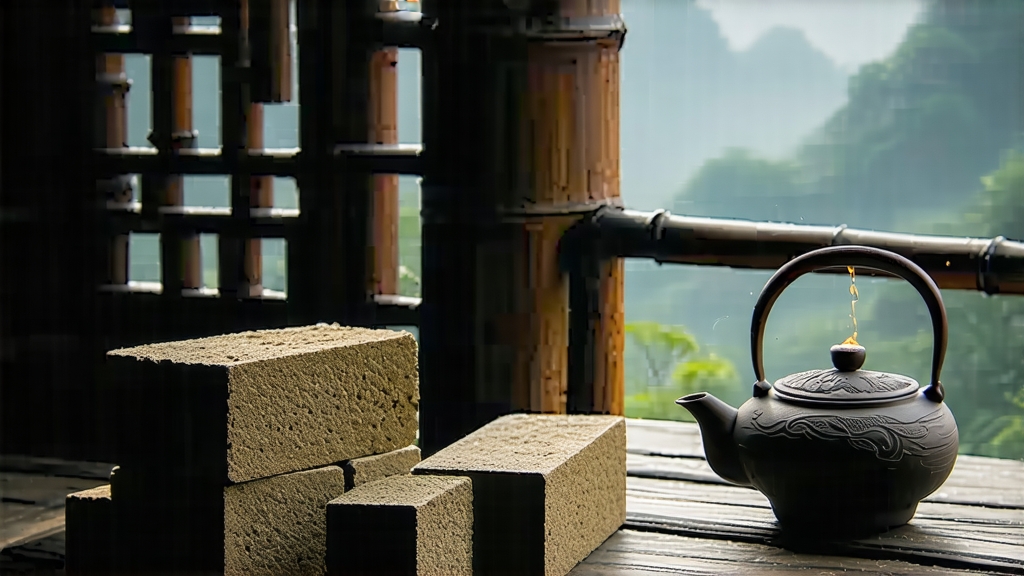
Tucked away in the humid, karst-pocked mountains of southern Guangxi, the small river town of Liubao gave the world a tea that once perfumed the holds of clipper ships sailing for London and blackened the copper kettles of Mongolian princes. Today, Liu Bao—literally “Six Forts”—remains the most travelled yet least understood member of China’s dark-tea family. While Pu-erh hoards the spotlight, Liu Bao has continued its quiet post-fermentation in bamboo baskets, emerging only when a slice of its compressed leaf is prized off with a tea knife and the room fills with the scent of damp forest floor, betel nut and long-forgotten mahogany.
A 1,500-year river of history
The first written record appears in the Jiaping County Annals of 1562: “Tea from Liubao, dark as lacquer, sweet as longan, cures miasma and damp.” By the Qing dynasty the leaf had become a tax commodity; imperial edicts of 1729 list Liu Bao among the “border teas” bartered with northern nomads for war horses. Jute-wrapped baskets—40 kg each—were rafted down the Liu River to Wuzhou, transferred to sampans on the Pearl River, and finally stacked in the holds of East India Company vessels bound for London where, labeled “Bohea Souchong,” it was drunk with sugar and milk. Caravans also carried it northward on the Ancient Tea-Horse Road; blocks of Liu Bao functioned as currency in Mongolia well into the 1930s.
From leaf to basket: the craft
Liu Bao is made only from the medium-leaf Camellia sinensis var. sinensis cultivars native to Guangxi. Picking begins after Qingming when two leaves and a bud still wear their spring down. The steps follow the classic dark-tea sequence—shaqing (kill-green), rolling, pile-fermentation, drying—but the terroir and micro-fauna give each stage a local accent.
- Wok firing: Leaves are tossed for three to four minutes at 160 °C, just enough to destroy leaf enzymes while preserving the thick cell walls that darker teas need for microbial drama later.
- Rolling: A 30-minute ride in a bamboo drum roller bruises the leaf and starts the juice exuding, but the twist is looser than that of green tea, leaving channels for air.
- Duiwo—“pile in the corner”: Instead of the giant Pu-erh heaps, Liu Bao is piled 60–70 cm deep on bamboo mats in a humid storeroom. A unique mix of Aspergillus niger, Blastobotrys adeninivorans and local yeasts—scientists call it the “Wuzhou microbiome”—colonizes the pile. Every two days the tea master “turns the wind,” inserting a bamboo pole to vent heat and sprinkle river water. After 30–40 days the leaf has turned chestnut-brown and smells of wet bark and jackfruit.
- Drying: Traditionally the tea is sun-dried on long bamboo racks, but if the monsoon lingers, charcoal roasting in a squat clay kiln finishes the job at 45 °C for six hours, adding a whisper of smoke.
- Steaming and pressing: The dried maocha is re-steamed for 90 seconds, then tipped into cylindrical bamboo baskets lined with wild banana leaf. A barefoot worker jumps in to compress the tea, tightening the basket lid with rattan hoops. These 30–50 kg “lan cha” (basket tea) units are stacked in riverside warehouses where year-round humidity keeps the microbes alive.
Styles and vintages
Liu Bao is classified by grade (特级, 一级, 二级) and by the year the basket was sealed. Young tea (1–3 years) tastes of raw cacao and dried longan; middle-aged (5–10 years) develops camphor and betel-nut notes; old tea (15-plus years) delivers mahogany, Chinese medicine chest and a lingering rock-sugar sweetness. A rare pre-1973 “Soviet basket”—pressed for export to the USSR—now fetches five-figure sums at Guangzhou auctions, its liquor the colour of black cherry and thick as broth.
How to brew it Gongfu style
Equipment: 120 ml Yixing clay teapot (zi-ni or du